Allow me to share some reflections, without any claim to scientific validity, but I hope they will still be useful to stimulate some thought.
The first two images depict a fragment of a vase and a “Ka” vase from the pharaonic dynasty 0; the third image refers to a “menhir di Laconi,” and the fourth to one of the similar vases found at the archaeological site of Sant’Anastasìa, within the settlement of Sardara.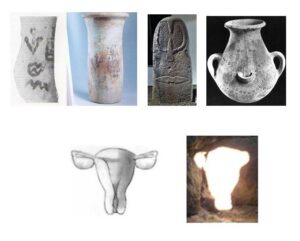 If the signs engraved on this last vase were “borrowed” from Egyptian hieroglyphic writing, the word “copper” or something similar could be read on its surface.
If the signs engraved on this last vase were “borrowed” from Egyptian hieroglyphic writing, the word “copper” or something similar could be read on its surface.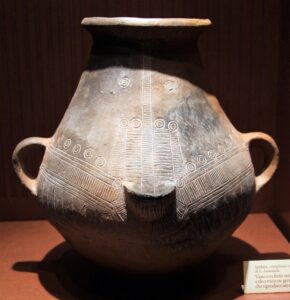 In fact, the solar circles translate to the word “ra,” the protruding cup, always in hieroglyphic terms, is read as “hm” and indeed signifies copper (but also uterus), while the Greek symbol for water is read as “n.”
In fact, the solar circles translate to the word “ra,” the protruding cup, always in hieroglyphic terms, is read as “hm” and indeed signifies copper (but also uterus), while the Greek symbol for water is read as “n.”
In the vase of Sant’Anastasìa, three elements projected upwards are also visible in the upper register, which could be interpreted as three nuragic towers, with the central one soaring, through which the sunlight (the circles) penetrates, which after traversing the maternal womb (the cup), intercepts the water (the Greek), the primary source of life. However, the three towers could also represent the inverted (trident).
In one way or another, the meaning of the whole does not change, as it is a symbol of the regeneration of life, with the sun (or the inverted understood as the soul of the deceased) returning to the maternal womb to reunite with the primordial water.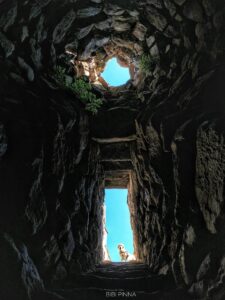 The same concept is echoed in the “Ka” vases, where the trident is analogous to our inverted one (with circles at the top symbolizing the sun) while, as mentioned, the hole with water (hm) means uterus and the Greek water. The same could be said for the petroglyphs engraved on the menhir of Laconi, where the symbol of water is absent (even though water is implicitly present beneath the ground in which such monoliths/perdas fittas were planted).
The same concept is echoed in the “Ka” vases, where the trident is analogous to our inverted one (with circles at the top symbolizing the sun) while, as mentioned, the hole with water (hm) means uterus and the Greek water. The same could be said for the petroglyphs engraved on the menhir of Laconi, where the symbol of water is absent (even though water is implicitly present beneath the ground in which such monoliths/perdas fittas were planted).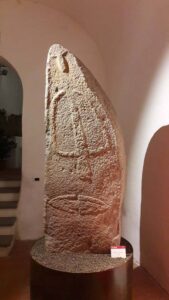 However, there is the inverted element in addition to the horizontal element, generally understood as an (unlikely) double-edged dagger but which, on the other hand, seems to once again depict the uterus, being very likely the emblem of the ithyphallic god Amon/Min, an androgynous deity that, as such, encompassed within itself the male and female sexual principles. This god, in the form of “Min-ka-mut-f” or “bull of his mother,” also symbolized procreative strength and fertility, and the reference to the bull (in Egypt the bull was called “ka” like the soul of man) suggests that the bull horns, present in various petroglyphs often found in the domus de janas, constituted a metaphor for procreative sexual power. Not only that, but the taurine protome that appears within the nuraghe S.Barbara di Villanova Truschedu during the winter solstice (“the Light of the Bull” – GRS) depicts, as noted in the last two images, also the section of a female genital apparatus, similarly to what occurred in representations of the androgynous god Amon-Min.
However, there is the inverted element in addition to the horizontal element, generally understood as an (unlikely) double-edged dagger but which, on the other hand, seems to once again depict the uterus, being very likely the emblem of the ithyphallic god Amon/Min, an androgynous deity that, as such, encompassed within itself the male and female sexual principles. This god, in the form of “Min-ka-mut-f” or “bull of his mother,” also symbolized procreative strength and fertility, and the reference to the bull (in Egypt the bull was called “ka” like the soul of man) suggests that the bull horns, present in various petroglyphs often found in the domus de janas, constituted a metaphor for procreative sexual power. Not only that, but the taurine protome that appears within the nuraghe S.Barbara di Villanova Truschedu during the winter solstice (“the Light of the Bull” – GRS) depicts, as noted in the last two images, also the section of a female genital apparatus, similarly to what occurred in representations of the androgynous god Amon-Min.
The photo of the nuragic well temple of Sant’Anastasìa in Sardara is by Bibi Pinna; that of the nuraghe Santa Barbara in Villanova Truschedu.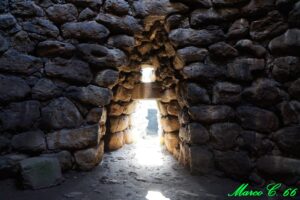 It is by Marco Cocco. The photo of one of the menhirs displayed in the museum of Laconi is by Beatrice Auguadro. On the cover: the interior of the nuraghe Santa Barbara in a shot by Francesca Cossu.
It is by Marco Cocco. The photo of one of the menhirs displayed in the museum of Laconi is by Beatrice Auguadro. On the cover: the interior of the nuraghe Santa Barbara in a shot by Francesca Cossu.

